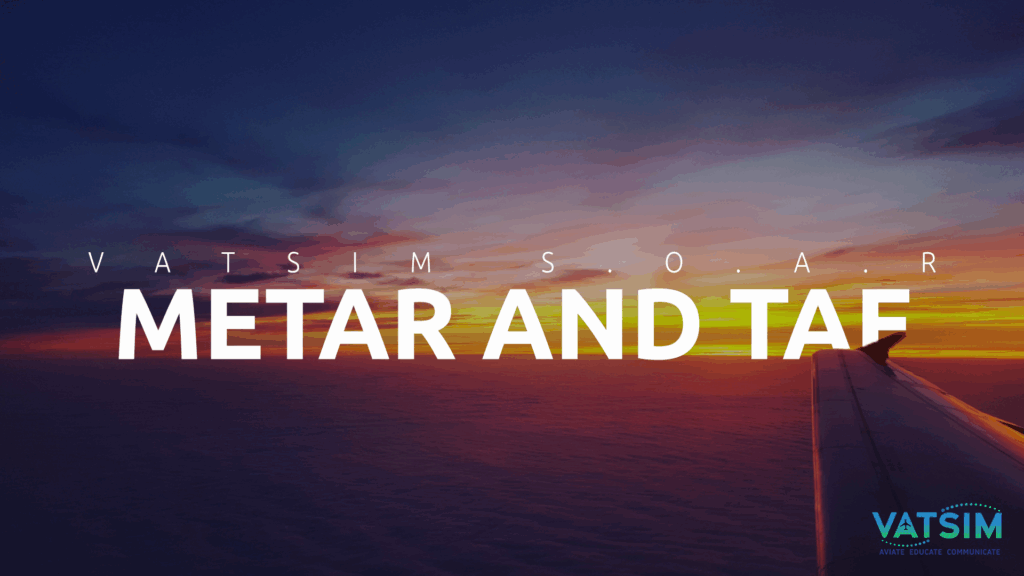
Understanding METARs and TAFs in Aviation and VATSIM
Weather reporting in aviation can seem complex at first, but learning to read METARs (observations) and TAFs (forecasts) gives pilots powerful tools for safer and more realistic flight planning. Whether you’re flying on VATSIM or preparing for real-world aviation, this skill is essential.
This guide explains how to read METARs and TAFs, with examples and a comparison of ICAO and FAA formats.
What is a METAR?
A METAR is a weather observation report issued at least once an hour. It provides information about the current conditions at an airport, including wind, visibility, temperature, cloud cover, and pressure.
Example METAR:
ORBI 191150Z 25012KT 9999 BKN030 17/11 Q1013 NOSIG
| Code Element | Meaning |
| ORBI | ICAO code for Baghdad International |
| 191150Z | Report issued on the 19th at 11:50 UTC |
| 25012KT | Wind from 250° at 12 knots |
| 9999 | Visibility greater than 10 kilometers |
| BKN030 | Broken clouds at 3,000 ft AGL |
| 17/11 | Temperature 17°C, dew point 11°C |
| Q1013 | Pressure 1013 hPa (QNH) |
| NOSIG | No significant weather changes expected in the next 2 hours |
Common METAR Abbreviations
| Code | Meaning |
| CAVOK | Ceiling and Visibility OK |
| NOSIG | No significant change expected in 2h |
| VRB | Variable wind direction |
| SHRA | Showers of rain |
| TS | Thunderstorm |
| RA | Rain |
| SN | Snow |
| FG | Fog |
| BR | Mist |
| FEW | Few clouds |
| SCT | Scattered clouds |
| BKN | Broken clouds |
| OVC | Overcast |
| +/- | Heavy/Light |
FAA-Specific Differences in METARs
| Feature | Global (ICAO) | United States (FAA) |
| Visibility | Meters (e.g., 9999) | Statute miles (e.g., 6SM) |
| Altimeter format | QNH in hPa (e.g., Q1013) | Inches of mercury (e.g., A2992) |
| Runway Visual Range | Meters | Feet (e.g., R28L/2600FT) |
| Corrections | Not always included | COR indicates correction |
| Remarks section | Optional | RMK often includes extra data |
What is a TAF?
A TAF (Terminal Aerodrome Forecast) is a forecast of expected weather conditions at an airport over a 24–30‑hour period. It is essential for IFR flight planning and decision-making about alternate airports and weather‑related delays.
Example TAF:
TAF EGLL 191100Z 1912/2018 24015KT 9999 SCT025
TEMPO 1915/1918 30018G30KT SHRA BKN020
| Code Element | Meaning |
| TAF EGLL | Forecast for London Heathrow |
| 191100Z | Issued at 11:00 UTC on the 19th |
| 1912/2018 | Valid from 12:00 UTC on the 19th to 18:00 UTC on the 20th |
| 24015KT | Wind from 240° at 15 knots |
| 9999 SCT025 | Visibility >10 km, scattered clouds at 2,500 ft |
| TEMPO 1915/1918 … | Temporary conditions between 15:00–18:00 UTC |
Common TAF Abbreviations
| Code | Meaning |
| FM | From: Sudden, significant change at a specific time |
| BECMG | Becoming: Gradual weather change over time |
| TEMPO | Temporary: Short-term fluctuations in weather |
| PROB30 | 30% probability of specified condition |
| PROB40 | 40% probability of specified condition |
| WS010/31022KT | Wind shear at 1,000 ft AGL from 310° at 22 kt |
FAA-Specific Differences in TAFs
| Feature | Global (ICAO) | United States (FAA) |
| Visibility | Meters | Statute miles |
| Altimeter setting | QNH in hPa | A in inches of mercury |
| Use of BECMG | Common | Rare in NWS civilian TAFs |
| Use of PROB30/40 | Anytime | Not used in the first 9 hours |
| Temperature forecasts | Sometimes included | Typically excluded |
| Trend forecasts | Included | Not used in U.S. METARs |
| Wind shear group | Rare outside U.S. | Frequently included in U.S. TAFs |
For more information, check the following:
https://skybrary.aero/sites/default/files/bookshelf/1543.pdf
